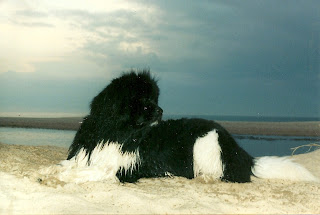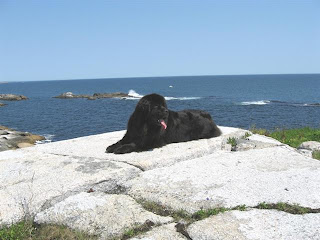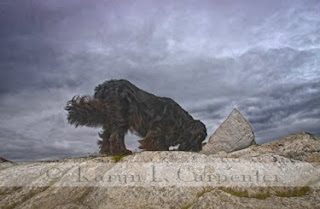
Our Newfoundlands can be tricky little stinkers to photograph. You've all received that Christmas Card or had someone send you a family photo and you know immediately that they have a Newf because there is this big black hole in the middle of the photograph - right? The black fur just sucks up all the light and can be a stinker to work with.
Kim Benedict sent me this image of her Newfoundland, Karma, taken on Lake Michigan. The background is lovely and she has caught a nice quiet moment with the dog. The light is getting low in the sky (see how bright it is off to the left of the frame?) and there is a nice quality of light because of that. Kim has also done what is one of the most important things to do when photographing a dog - she's gotten down on Karma's level. She may actually be laying in the sand to take this image. Good! If you are going to photograph Newfs, just plan on getting filthy!
Even thought the dog is pretty centrally positioned in the frame, I think it is fine. There isn't a lot of detail around to balance off-setting the dog. While basically centered, she is nice and close to the dog without crowding it in the frame.
The problem is that the light behind the dog is quite bright and the camera is exposing for the background, and not the dog. Because she is photographing this black hole, she needs MORE light on the dog! The camera flash has gone off (notice how bright the foreground is?) but it is still not compensating for the brightness of the background.
There are a couple things that can be done to help compensate for the background but they are kind of advanced and frankly, with Newfs, can be iffy, so let's take the easy route! MOVE!
See that stretch of sand behind Karma? How about going out there and positioning Karma so that nicely angled light is now striking the dog? Now the dog AND the background are lit. Move around a bit. You can still pick up sand and water as a background by looking for additional vantage points. (When I photograph at a lake or the ocean, I often have my tall rubber boots on so that I can get out into the water while my subjects are on land.) Kim said that this image was taken near a lighthouse. Hum….. What if the lighthouse was in the background?
WARNING - evening light is fabulous! (morning light not so, because you have to wake up to catch it - grrrrrr…..) but beware of shadows. If you are photographing something that is being struck by low light - you have to position yourself so that your shadow is not in the frame. Just another challenge for you!
I took this image and removed the stick that was at the right of the frame because it was distracting. I have tried to lighten the dog. I've also darkened the edges a bit because it was drawing my eye out of the frame - particularly on the left, but this is a reshoot because the detail isn't there in the dog. Again, Kim did a lot just right with this photograph, it just begs for more detail in the black.
One final point. Karma is watching something off to the right of the frame. I keep wanting to pull her nose just a few inches back toward the camera so we pick up a hint of that other eye and her head doesn't seem to be tilting so far back. But, that isn't a deal breaker - now I'm just being picky, but it is something to think about for a reshoot.
Kim, this really is a beautiful photograph and you were working in a really challenging lighting situation. Take that goofy girl back to the beach and let the light hit her - then you've got it nailed! And, please send in a copy of the new version, okay?





